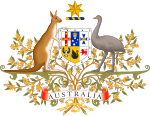High Court of Australia
| High Court of Australia | |
|---|---|
 |
|

The High Court and its surroundings
|
|
| Established | 1903 |
| Country | Australia |
| Location | Canberra, Australian Capital Territory |
| Composition method | Vice-regal appointment upon Prime Ministerial nomination, following advice of Attorney-General and Cabinet |
| Authorized by | Constitution of Australia |
| Judge term length | Until age of 70 years (Constitution of Australia, s 72 following 1977 referendum) |
| No. of positions | 7, by statute |
| Website | www.hcourt.gov.au |
| Chief Justice of Australia | |
| Currently | Susan Kiefel |
| Since | 30 January 2017 |
 |
| Australian court hierarchy |
|
Federal Law Courts |
|
Courts of Australian states and territories |
The High Court of Australia is the supreme court in the Australian court hierarchy and the final court of appeal in Australia. It has both original and appellate jurisdiction, the power of judicial review over laws passed by the Parliament of Australia and the parliaments of the States, and the ability to interpret the Constitution of Australia thereby powerfully shaping the development of federalism in Australia.
The High Court is mandated by Constitution section 71, which vests in it the judicial power of the Commonwealth of Australia. The Court was constituted by, and its first members were appointed under, the Judiciary Act 1903. It now operates under Constitution sections 71 to 75, the Judiciary Act, and the High Court of Australia Act 1979. It is composed of seven Justices: the Chief Justice of Australia, currently Susan Kiefel, and six other Justices. They are appointed by the Governor-General of Australia, on the advice of the federal government, and under the constitution must retire at age 70.
Since 1979, The High Court has been located in Canberra, Australian Capital Territory. The majority of its sittings are held in the High Court building, situated in the Parliamentary Triangle, overlooking Lake Burley Griffin. With an increasing utilisation of video links, sittings are also commonly held in the state capitals.
The High Court exercises both original jurisdiction (cases that originate in the High Court) and appellate jurisdiction (appeals made to the High Court from other courts). The High Court is the court of final appeal with the ability to interpret the common law for the whole of Australia, not just the state or territory in which the matter arose. The High Court's broad jurisdiction is similar to that of the Supreme Court of Canada and unlike the Supreme Court of the United States which has a more limited jurisdiction. As such, the court is able to develop the common law consistently across all the states and territories. This role, alongside its role in constitutional interpretation, is one of the court's most significant. As Sir Owen Dixon said on his swearing in as Chief Justice of Australia:
...
Wikipedia
